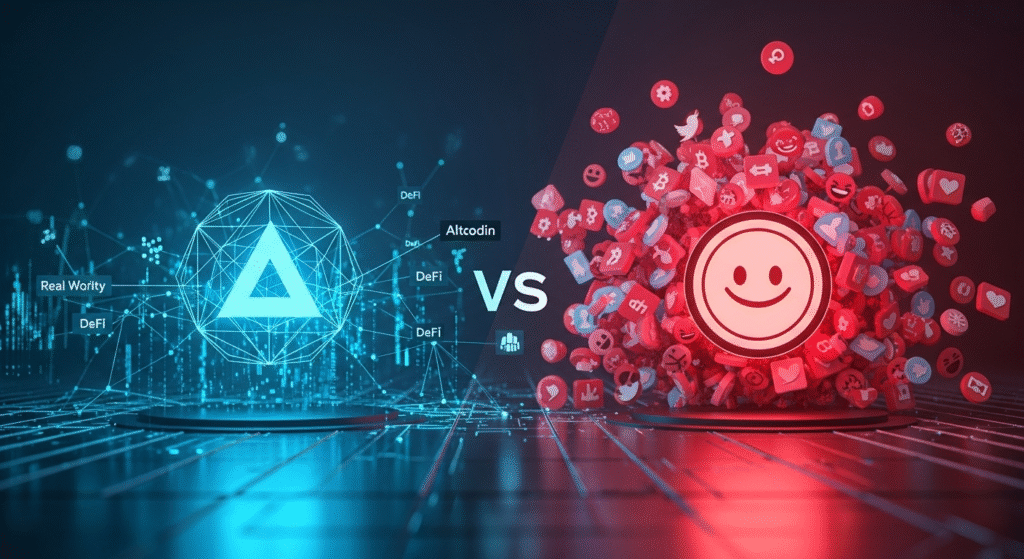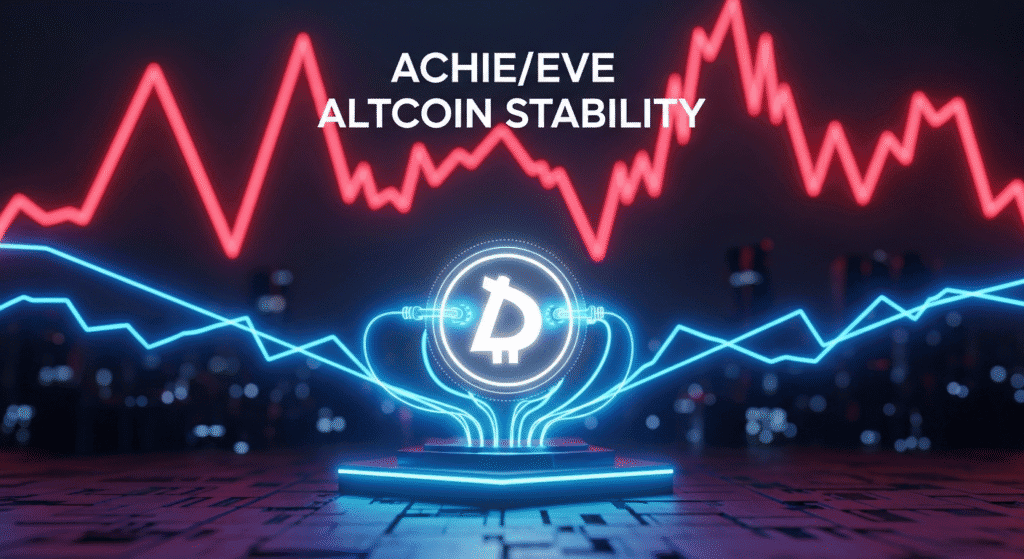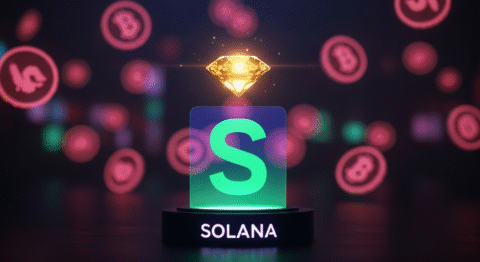introdution
Are you tired of watching your altcoin portfolio resemble a rollercoaster from a particularly volatile theme park, especially when compared to the perceived stability of major cryptocurrencies? What if there were proven strategies to anchor your digital assets, effectively mirroring the coveted stability of a robust Stablecoin Peg? In a crypto landscape often defined by unpredictable swings, understanding the principles that underpin stablecoins isn’t just about observing them; it’s about leveraging those insights to protect and potentially grow your altcoin investments.
Crypto Market Overview
The cryptocurrency market, a dynamic and ever-evolving ecosystem, has recently demonstrated a fascinating blend of established trends and emerging opportunities. While Bitcoin and Ethereum continue to set the pace, the altcoin sector has witnessed significant activity, driven by innovation, specific use cases, and the ever-present speculative fervor. We’re seeing a renewed interest in utility tokens, projects aiming to solve real-world problems, and, of course, the persistent allure of meme coins, which, despite their often-unpredictable nature, continue to capture market attention and significant trading volume. Airdrops, too, remain a popular method for token distribution and community building, often serving as an entry point for new investors into various altcoin projects.
Key market indicators are painting a diverse picture. While some major altcoins are consolidating or experiencing moderate gains, others are highly susceptible to market sentiment shifts, often mirroring the broader economic climate and regulatory news. The total crypto market capitalization fluctuates, but the underlying technological advancements and the increasing adoption of blockchain technology across various industries suggest a sustained interest in this asset class. Understanding these overarching trends is crucial for any investor looking to make informed decisions, especially when focusing on specific segments like altcoins or the strategies that can enhance their stability, much like a well-managed Stablecoin Peg.

The Core Concept: How Altcoin Stability Works
To truly grasp the secrets for altcoin stability, we first need to understand the foundational elements of the digital assets that often present these challenges: altcoins, meme coins, and airdrops.
What Are Altcoins / Meme Coins / Airdrops?
Altcoins, a portmanteau of “alternative coins,” are essentially any cryptocurrencies other than Bitcoin. They represent a vast and diverse category, born from the desire to improve upon Bitcoin’s perceived limitations or to explore entirely new functionalities and use cases. From smart contract platforms like Ethereum and Solana to privacy-focused coins like Monero, and decentralized finance (DeFi) tokens, altcoins offer a spectrum of technological innovation and investment potential. Their purpose can range from powering decentralized applications (dApps) and facilitating smart contracts to enabling peer-to-peer payments with enhanced features or focusing on specific niche markets.
Meme coins, on the other hand, often originate from internet jokes, memes, or community-driven sentiment rather than a robust technological foundation or a clear utility from inception. Dogecoin and Shiba Inu are prime examples. While their initial purpose might have been entirely speculative or based on humor, many meme coins have developed active communities, use cases, and even undergo token burns or staking mechanisms. Their volatility is often amplified by social media trends and the “fear of missing out” (FOMO) phenomenon.
Airdrops are a distribution strategy where new cryptocurrencies are sent out to a large number of wallets for free, typically to promote a new coin, reward existing holders of another cryptocurrency, or incentivize certain actions within a blockchain ecosystem. They serve as a promotional tool and a way to decentralize the initial distribution of tokens, often attracting new users to a particular network or project.
Key Components & Technologies
The stability and functionality of altcoins, meme coins, and the broader crypto ecosystem are underpinned by a variety of technological components and economic principles.
- Blockchain Technology: At its core, most altcoins operate on a blockchain, a distributed, immutable ledger that records transactions across many computers. This decentralized nature enhances security and transparency. Different consensus mechanisms, such as Proof-of-Work (PoW), Proof-of-Stake (PoS), or Delegated Proof-of-Stake (DPoS), influence a blockchain’s security, scalability, and energy consumption, all of which can indirectly affect token stability.
- Smart Contracts: Many altcoins, particularly those built on platforms like Ethereum, utilize smart contracts – self-executing contracts with the terms of the agreement directly written into code. These enable complex decentralized applications (dApps), automated financial instruments (DeFi), and even automated token distribution or vesting schedules, which can play a role in market stability.
- Tokenomics: This is perhaps the most critical component for understanding value and stability. Tokenomics refers to the design and economic model of a cryptocurrency. It encompasses factors like the total supply, circulating supply, inflation/deflation mechanisms (e.g., token burns), staking rewards, vesting schedules for early investors, and governance mechanisms. Well-designed tokenomics can create demand, manage supply, and incentivize long-term holding, all contributing to a more stable Stablecoin Peg for that specific asset.
- Decentralized Finance (DeFi): The rise of DeFi has introduced new mechanisms for liquidity provision, lending, and borrowing, often involving altcoins. Protocols that facilitate stablecoin issuance, yield farming, and decentralized exchanges (DEXs) can influence the liquidity and demand for various altcoins, indirectly impacting their stability.
- Community and Governance: For many altcoins, especially meme coins, the strength and engagement of their community are paramount. Community-driven initiatives, such as marketing efforts, development proposals, and even coordinated buying pressure, can significantly influence price action and perceived stability. Decentralized governance models, where token holders can vote on project development, also contribute to long-term sustainability.
The Data-Driven Perspective
To truly understand how to achieve greater altcoin stability, we must delve into the data and observable market trends.
Market Data & Trends
Analyzing historical data reveals a consistent pattern: altcoins, by their very nature, tend to exhibit higher volatility than Bitcoin. However, this doesn’t mean all altcoins are destined for erratic price swings. Projects with strong fundamentals, clear use cases, and robust development communities often show more resilience.
For instance, data from crypto analytics platforms often shows that altcoins with lower market capitalization are more susceptible to significant price drops when market sentiment turns negative. Conversely, during bull runs, they can experience exponential growth. The narrative surrounding an altcoin – whether it’s linked to AI, gaming, specific DeFi protocols, or trending meme culture – heavily influences its performance.
Recent trends indicate that utility-focused altcoins, those driving innovation in areas like decentralized identity, supply chain management, or advanced DeFi protocols, are attracting more sustained interest. Meme coins, while still capable of generating explosive short-term gains, often experience sharp corrections once the hype subsides. Airdrops, when tied to established projects or those with genuine utility, can boost the adoption and initial value of a token, but their long-term impact on stability depends on continued development and community engagement. Understanding these trends allows for a more strategic approach than simply chasing the latest viral sensation.
Tokenomics & Market Health
The inner workings of a cryptocurrency’s tokenomics are a critical determinant of its long-term health and potential for stability.
- Supply and Demand Dynamics: A fixed or strategically decreasing supply (through token burns) can create scarcity and potentially drive up prices, assuming demand remains constant or grows. Conversely, an uncapped or rapidly inflating supply can dilute value and lead to downward pressure. For example, Ethereum’s transition to Proof-of-Stake (The Merge) and the subsequent EIP-1559, which burns ETH, have introduced deflationary pressures, impacting its tokenomics in a way that can contribute to its perceived stability relative to other inflation-prone assets.
- Utility and Value Accrual: Does the token have a real-world use case within its ecosystem? Can holders stake it to earn rewards, use it to pay for services, or govern the network? Tokens with strong utility and clear mechanisms for value accrual tend to be more stable as demand is driven by intrinsic use rather than pure speculation. Projects that can prove their utility and build a strong user base often exhibit a more consistent Stablecoin Peg in terms of demand relative to supply.
- Vesting Schedules and Distribution: The distribution of tokens among early investors, founders, and the public can significantly impact market stability. If a large percentage of tokens is held by a few early participants, they could dump their holdings, causing a sharp price drop. Transparent and well-structured vesting schedules, which release tokens gradually over time, can help prevent such market shocks, contributing to a more controlled and predictable environment.
Risks, Challenges & Competition
While the appeal of altcoins is undeniable, so are the inherent risks and the competitive landscape they navigate.
Risks of Altcoins and Meme Coins
Investing in altcoins and meme coins comes with a distinct set of risks that potential investors must be acutely aware of:
- Extreme Volatility: As mentioned, altcoins are generally more volatile than Bitcoin. This means prices can skyrocket, but they can also plummet drastically and rapidly, leading to significant losses for unprepared investors. Meme coins are particularly prone to extreme price swings driven by social media sentiment and influencer activity.
- Security Vulnerabilities: The blockchain technology underlying some altcoins may have undiscovered vulnerabilities, or the smart contracts governing them could contain bugs. Hacks and exploits can lead to the theft of funds and a complete loss of value for the token.
- Regulatory Uncertainty: The regulatory landscape for cryptocurrencies, especially altcoins and newer projects, is still evolving. Governments worldwide are grappling with how to classify and regulate these assets, and new regulations could impact their legality, trading, and overall value.
- Lack of Utility and Adoption: Many altcoins fail to gain significant traction or develop a sustainable use case. If a project doesn’t attract users or developers, its token may become obsolete, leading to a total loss of investment. Meme coins, in particular, often lack fundamental utility, making their value solely dependent on continued community interest and speculative buying.
- Rug Pulls and Scams: The decentralized nature of crypto also makes it a fertile ground for malicious actors. “Rug pulls” – scenarios where developers abandon a project and run off with investor funds, often after inflating the token’s price artificially – are a significant risk, particularly in the meme coin and DeFi space.
How Does [TOPIC] Stack Up Against Competitors?
This question is best answered by looking at the specific altcoin or meme coin you’re considering. However, we can generalize by examining how different categories of altcoins compete and where they often fall short, particularly in their pursuit of stability akin to a robust Stablecoin Peg.
Let’s compare a hypothetical utility-driven altcoin (let’s call it “UtilityX”) against a popular meme coin (“MemeRocket”) and a stablecoin (like USDC).
| Feature | UtilityX (Hypothetical Utility Altcoin) | MemeRocket (Hypothetical Meme Coin) | USDC (Example Stablecoin) |
|---|---|---|---|
| Primary Goal | To provide a service, platform, or solution within a specific industry (e.g., supply chain, gaming, data management). | To leverage community, social media, and speculative trading for price appreciation. Often starts as a joke or cultural phenomenon. | To maintain a stable value, typically pegged to a fiat currency like the US Dollar, through collateralization and reserve management. |
| Volatility | Moderate to High. Influenced by project development, adoption rates, and broader market sentiment, but often less extreme than meme coins. | Extremely High. Driven by social media trends, influencer endorsements, high trading volume, and speculative FOMO. Prone to rapid pumps and dumps. | Very Low to None. Designed to maintain a 1:1 peg. Significant deviations are rare and usually indicate an exploit or breakdown in the peg mechanism. |
| Underlying Tech | Often employs advanced blockchain features, smart contracts, and specific protocols tailored for its use case. Focus on scalability and security. | Varies. Can be built on existing blockchains (e.g., Ethereum) or have its own, often with simpler, less robust technology. Focus is often on community and branding. | Backed by reserves of fiat currency or other stable assets, with a strong emphasis on transparency, audits, and regulatory compliance in its reserve management. |
| Tokenomics | Focus on utility, governance participation, staking rewards, and mechanisms that encourage long-term holding and usage. | Can be highly variable. Often features large supplies, frequent burns, and incentives for holding/staking from community. Demand is primarily speculative. | Designed for stability. Managed supply to maintain the peg, often through minting and burning mechanisms linked to collateral. |
| Risk Profile | Medium to High. Risks include project failure, low adoption, regulatory changes, and market volatility. Potential for significant gains if successful. | High to Very High. Risks include total loss of value due to lack of utility, “rug pulls,” extreme volatility, and dependence on social media trends. | Low. Risks are primarily systemic (e.g., failure of the issuer, regulatory clampdowns on stablecoins), but the technological peg mechanism is robust for intended purpose. |
| Stability | Moderate. Aims for incremental growth and stability through its utility. Less prone to wild swings than meme coins. | Very Low. Designed for speculative gains, not stable value. Any semblance of a Stablecoin Peg is purely coincidental and short-lived. | High. The primary objective is to maintain a stable value, making them a foundational element for trading and DeFi. |
This comparison highlights that while utility altcoins aim for a degree of stability through their function, they are still subject to market forces. Meme coins, inherently, do not prioritize stability. Stablecoins, by definition, are built for it. The secrets for enhancing altcoin stability lie in understanding how to infuse elements of UtilityX’s approach with the disciplined management that stablecoins employ, while acknowledging the different risk profiles.
The Future Outlook
What’s Next for Altcoins / Meme Coins / Airdrops?
The future for altcoins, meme coins, and airdrops is likely to be shaped by several ongoing trends and emerging developments:
- Increased Focus on Real-World Utility: As the crypto market matures, the emphasis is shifting from pure speculation to tangible use cases. Altcoins that solve genuine problems, enhance existing processes, or create new decentralized services are poised for long-term success. Expect to see more projects integrating blockchain technology into supply chains, finance, gaming, and digital identity.
- Regulatory Clarity: While often viewed with apprehension, increased regulatory clarity could actually be a positive force for stability. Clear guidelines for token issuance, trading, and usage could foster greater institutional adoption and reduce the risk of sudden crackdowns. This clarity could also help differentiate legitimate projects from scams, leading to more predictable market behavior for compliant altcoins.
- Layer-2 Scalability Solutions: For blockchains like Ethereum, the ongoing development and adoption of Layer-2 scaling solutions (e.g., rollups) are crucial for reducing transaction fees and increasing throughput. This will make dApps and altcoins built on these networks more accessible and practical for everyday use, potentially boosting their stability and adoption.
- Evolution of Meme Coins: While their speculative nature is unlikely to disappear entirely, some meme coins may evolve to incorporate more utility, community governance, or DeFi integration. The most resilient meme coins could transition from pure internet phenomena to more established digital assets with active ecosystems, though this remains a speculative path.
- Airdrops as Strategic Tools: Airdrops will likely continue to be a valuable tool for community building, bootstrapping network effects, and rewarding loyal users. However, projects will need to be more strategic, perhaps tying airdrops to participation in their ecosystem or loyalty programs, rather than just arbitrary wallet snapshots, to ensure they contribute to sustainable growth and a stable user base.
- Interoperability: As the blockchain space fragments into numerous specialized networks, interoperability solutions that allow different blockchains to communicate and exchange assets will become increasingly vital. Altcoins that are designed to be interoperable will have a significant advantage in reaching wider audiences and integrating into a more interconnected digital economy.
Conclusion
Navigating the altcoin market can feel like charting a course through unpredictable seas, but by understanding the principles behind stability, you can chart a more informed and potentially more fruitful journey. We’ve explored how robust tokenomics, genuine utility, strong community engagement, and a keen awareness of market data are crucial for fostering altcoin stability, aiming for a more dependable value proposition akin to a well-maintained Stablecoin Peg.
Remember, the crypto landscape is constantly evolving. Staying informed is your most powerful tool. We encourage you to share your thoughts on altcoin stability in the comments below – what strategies have worked for you? What are your predictions for the future? For more in-depth insights and data-driven strategies to grow your crypto portfolio, be sure to explore our other articles on [link to a similar article on your blog about altcoin strategies] and subscribe to our newsletter for regular updates.
FAQs
Q1: What is the most important factor for an altcoin’s stability?
The most critical factor is a combination of strong, well-defined utility and sound tokenomics. An altcoin that solves a real problem and has a tokenomics model that incentivizes holding and usage is more likely to achieve relative stability compared to those driven purely by speculation.
Q2: How can I identify an altcoin with good potential for stability?
Look for projects with active development teams, a clear roadmap, transparent tokenomics, a growing community, and demonstrable use cases. Research the token’s utility and how it accrues value within its ecosystem. Also, examine the distribution of tokens and any vesting schedules.
Q3: Are meme coins ever stable?
Generally, no. Meme coins are inherently speculative and driven by sentiment, making them extremely volatile. While some might experience periods of relative calm, they are not designed for stable value and should be approached with appropriate risk management.
Q4: How do airdrops affect altcoin stability?
Airdrops can initially increase the circulating supply and create selling pressure if recipients immediately sell. However, if an airdrop is strategically targeted at active users or community members of a project with strong fundamentals, it can boost adoption and long-term value, indirectly contributing to stability.
Q5: What’s the difference between an altcoin and a stablecoin?
Altcoins are alternative cryptocurrencies to Bitcoin, with values that typically fluctuate. Stablecoins are cryptocurrencies designed to maintain a stable value, usually pegged to a fiat currency like the US Dollar, often through collateralization. The pursuit of maintaining a Stablecoin Peg is central to the identity and function of stablecoins, a goal that most altcoins do not share due to their inherent design for growth and speculation.






